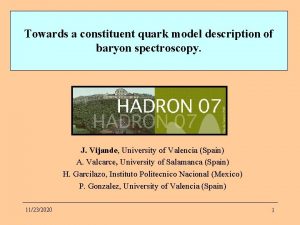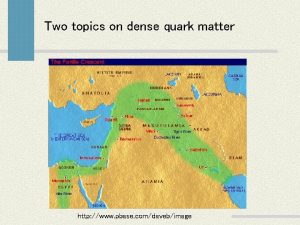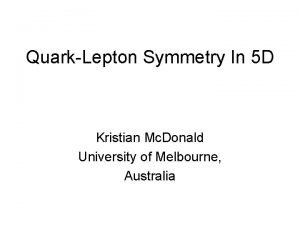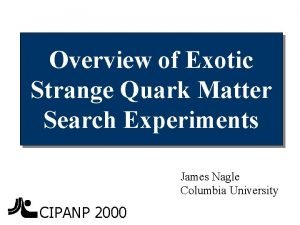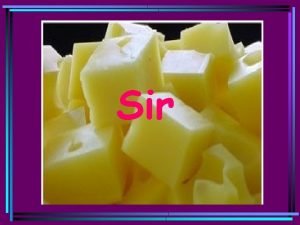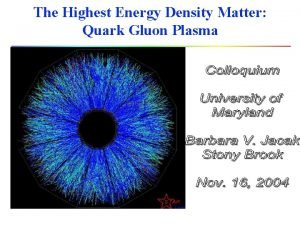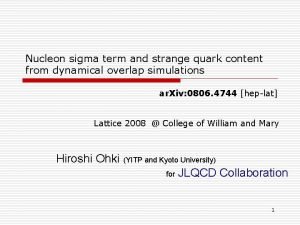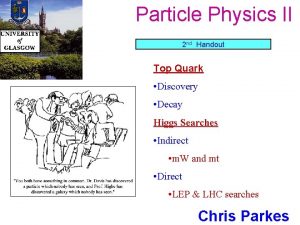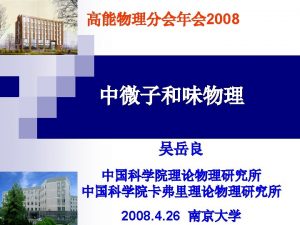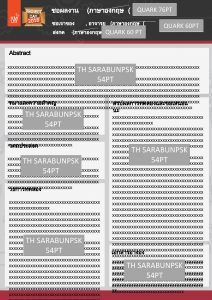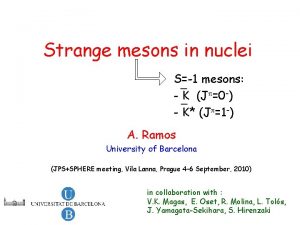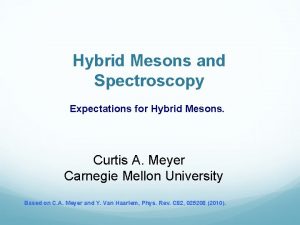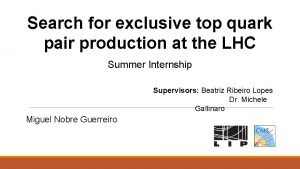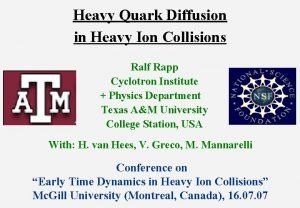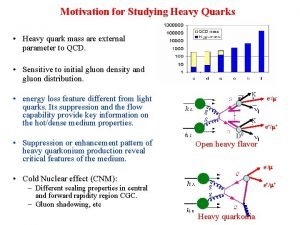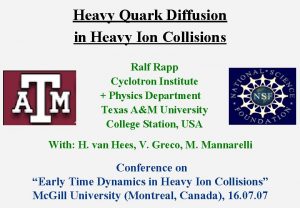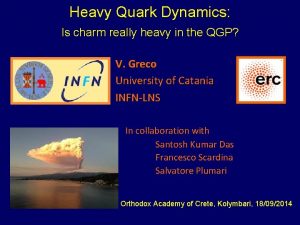Exclusive Production of Heavy Quark Mesons in pp











- Slides: 11

Exclusive Production of Heavy Quark Mesons in pp and pp collisions Spencer Klein, LBNL & Joakim Nystrand, Bergen Photoproduction of heavy vector mesons in pp/pp collisions Rates and rapidity distributions Interference and p. T spectra Backgrounds Conclusions

Photoproduction n n A photon from the electromagnetic field of one nucleus interacts with the other nucleus, producing a vector meson u Either nucleus can be photon source u The photon flux extends up to 0. 1 Ep or higher Ecm kmax (target) Wgpmax RHIC 500 Ge. V 12. 5 Te. V 158 Ge. V Tevatron 2. 0 Te. V 50 Te. V 316 Ge. V LHC 14 Te. V 1 Pe. V! 4. 4 Te. V These photons can probe low-x gluons Gluon x Y (y=0) Gluon x J/Y (y=0) RHIC 0. 02 0. 006 Tevatron 0. 005 0. 0015 LHC 0. 0007 0. 0002 S. Klein, LBNL

Photon Flux n n From Weizsacker-Williams b > 2 Rp; u no hadronic interactions F u Take bmin ~ 0. 7 fm F n Clean event signatures Change to bmin = 1. 0 fm is error estimate Sensitive to proton form factor u Qmin 2=k/g Drees and Zeppenfield, 1989 S. Klein, LBNL

Vector Meson production I Theory n gg collision at lowest order u n Need another gluon to conserve color Refinements Relativistic wave functions u Off diagonal parton dists. u NLO contributions u n Sensitive to gluon distributions u Q 2=MV 2/4 Ryskin, 1993 S. Klein, LBNL

ZEUS U Meson production II Experiment n HERA data u J/Y: s~ W 0. 8 F u U: agreement with theory s ~ W 1. 7 limited statistics F U(1), U(2), U(3) not separated F Estimate 80% U(1) Wgp (Ge. V) F H 1/ZEUS J/y • Alternately, use s~ W 0. 8 F n So-so match with theory Tevatron reaches slightly higher Wgp u Lower gluon x Wgp (Ge. V) S. Klein, LBNL Wgp (Ge. V)

Cross Sections, Rates and ds/d n Photon energy -> rapidity u n The U @ RHIC u u n RHIC @ 500 Ge. V (top) (500 Ge. V, 1031 cm-2 s-1) 0. 4/hr difficult The U @ the Tevatron (1. 8 Te. V, 2*1032 cm-2 s-1) u u n Y = ½ ln (2 k/MV) 76/hr Easy J/Y rates are high The Tevatron (bottom) S. Klein, LBNL

Interference n Either proton can act as emitter or target u n n Can’t differentiate between How to transform diagram 1 into 2? u For pp -> parity transform u For pp -> CP transform U and J/y are JPC = 1 -u pp: subtract amplitudes u pp add amplitudes

p. T spectra n u n Different from AA Interference is relevant for most of production p. T range pp --> pp. U (RHIC) (the Tevatron) d. N/dp. T 2 n pp & pp are very different! <b> ~ few rp p. TP >> p. Tg d. N/dp. T 2 n Solid – interference Dashed – no interference S. Klein, LBNL

Interference or no interference? n Interference occurs when we can’t tell which nucleus emitted the photon u What if scattered proton is detected in a Roman pot? Most of the VM p. T comes from the target proton, so a measurement of the proton p. T can determine where the photon came from. F But, what about timing? F • What if the J/Y or U is detected before the proton hits the Roman pot? u If detection in a Roman pot destroys the interference, then this can be used to remove the 2 -fold ambiguity and study gluons at very low x values S. Klein, LBNL

Backgrounds n s(p(g)p --> (J/Y or U)pp) ~ 10 -3 s(pp --> (J/Y or U)X). u Is n n the signal visible? Cutting on p. T < 1 Ge. V/c eliminates 94% of the hadroproduction. Rapidity gaps eliminate the rest. u At the Tevatron dnch/dy ~ 3. 9. F 3 units of rapidity gap --> exp(-3*3. 9) ~ 10 -5. F There are gaps on both sides. • The 3 units can be split between both sides. • 3 units of coverage is easy. • Similar numerology at RHIC; even easier at the LHC. n Quantum numbers wrong for Pomeron-Pomeron. S. Klein, LBNL

Conclusions n Photoproduction of heavy vector mesons is substantial in pp and pp colliders. u The rates are sensitive to the gluon distribution in the proton. n Production at the two sources can interfere. The sign of this interference is different for pp and pp collisions. u The p. T spectrum of produced mesons is very different for pp and pp collisions. S. Klein, LBNL



